How to count the total number of items (emails) in all folders in Outlook?
In Outlook, it automatically shows the number of unread items/emails beside folder name in the Navigation pane as right screenshot shown. But now, you need to count the total number of items/emails instead of only unread ones, how? Below workarounds will solve this problems easily!
- Count total number of items/emails in one folder
- Count total number of items/emails in each folder with Kutools for Outlook
- Count total numbers of all items/emails in all/multiple folders
- Count total number of items/email in each folder with VBA
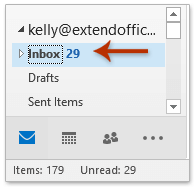
Count total number of items/emails in one folder
For counting the total number of items/emails in one folder in Outlook, you can easily change this folder’s properties to archive it.
1. In the Navigation Pane, right click the folder whose total number of items you will count, and select "Properties" from the right-clicking menu. See screenshot below:
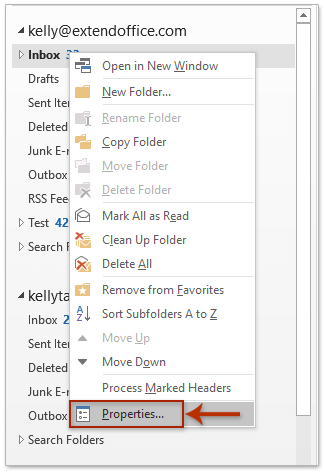
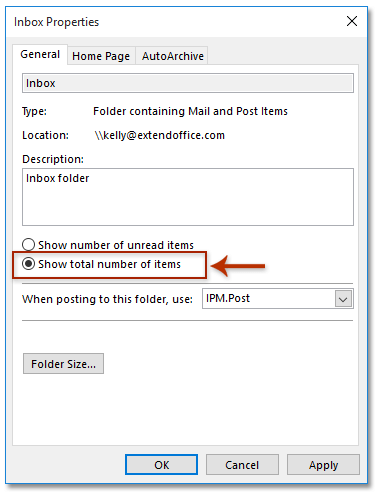
2. In the opening Properties dialog box, please check the "Show total number of items" option, and click the "OK" button. See screenshot above:
And now the number of unread items beside the folder name is replaced with the total number of all items/emails. See screenshot:
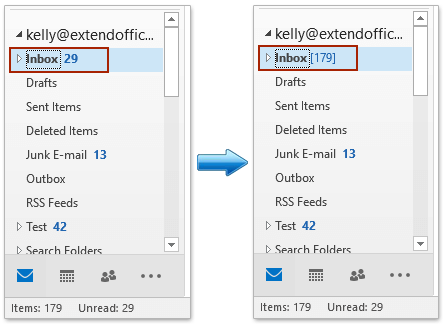
Notes:
(1) After selecting the folder in Navigation Pane, the number of all emails and number of unread emails are also shown at the "Status bar".
(2) This method can only show one folder’s total number of items/emails at a time. For showing the total numbers of items of all folders, please try below VBA.
AI Mail Assistant in Outlook: Smarter Replies, Clearer Communication (one-click magic!)
Streamline your daily Outlook tasks with the AI Mail Assistant from Kutools for Outlook. This powerful tool learns from your past emails to offer intelligent and accurate responses, optimize your email content, and help you draft and refine messages effortlessly.

This feature supports:
- Smart Replies: Get responses crafted from your past conversations—tailored, precise, and ready to go.
- Enhanced Content: Automatically refine your email text for clarity and impact.
- Effortless Composition: Just provide keywords, and let AI handle the rest, with multiple writing styles.
- Intelligent Extensions: Expand your thoughts with context-aware suggestions.
- Summarization: Get concise overviews of long emails instantly.
- Global Reach: Translate your emails into any language with ease.
This feature supports:
- Smart email replies
- Optimized content
- Keyword-based drafts
- Intelligent content extension
- Email summarization
- Multi-language translation
Don’t wait—download AI Mail Assistant now and enjoy!
Count total numbers of items/emails in each folder with Kutools for Outlook
If you have Kutools for Outlook installed, you can quickly count the total number of all items/emails in each folder with its" All Folders Show Total Number of Items" feature. Please do as follows:
Say goodbye to Outlook inefficiency! Kutools for Outlook makes batch email processing easier - now with a 30-day free trial! Download Kutools for Outlook Now!!
Click "Kutools Plus" > > "Folder" > "All Folders Show Total Number of Item".
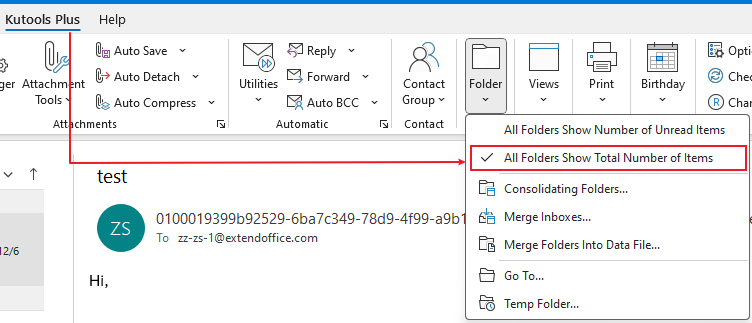
And now the number of unread items behind each folder on the "Navigation" Pane is changed to the the total number of all items immediately. See screenshot:

Count total numbers of all items/emails in all/multiple folders
All of above methods are talking about counting the total number of all emails in each folder. Have you ever thought of summing the numbers of item in each folder and returning a total number? This method will introduce Kutools for Outlook's "Statistics" feature to count the total number of all/multiple items in all folders.
Say goodbye to Outlook inefficiency! Kutools for Outlook makes batch email processing easier - now with a 30-day free trial! Download Kutools for Outlook Now!!
1. Click "Kutools Plus" > "Statistics". See screenshot:

2. Click the "OK" button directly in the first Statistic dialog box.
Note: By default all folders in all email accounts are selected. For counting total numbers in several/multiple folders, please check them only and click the "OK" button.
And now the second Statistic dialog box comes out, and you will get the total number of all items/emails in all folders of all email accounts configured in your Outlook. See screenshot:
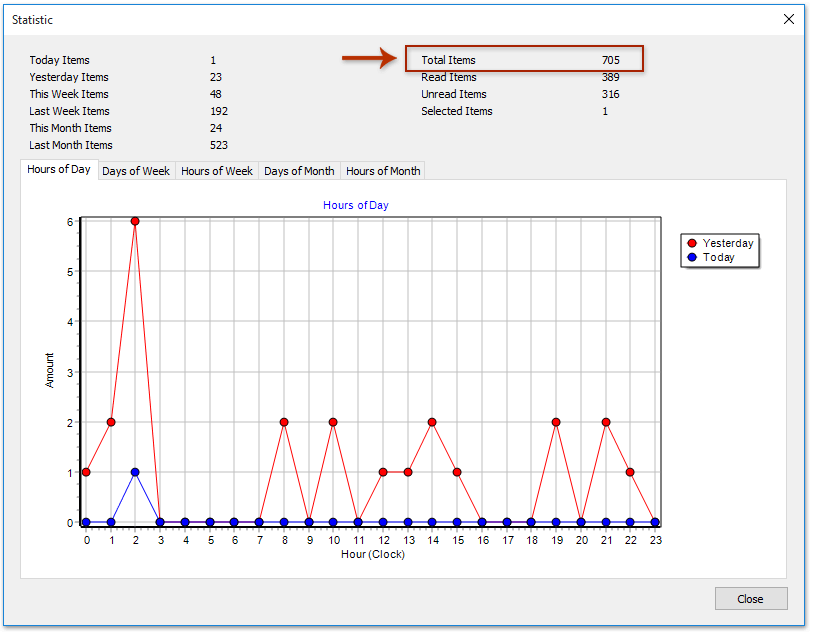
Count total numbers of items/email in all folders with VBA
For counting the total numbers of all items in all folders, please apply below VBA code in Outlook.
1. Press "Alt"+ "F11" keys simultaneously to open the Microsoft Visual Basic for Applications window.
2. Click "Insert" > "Module", and then paste below VBA code into the new opening Module window.
VBA: Count/show total numbers of items/emails in all folders in Outlook
Sub ShowTotalInAllFolders()
Dim oStore As Outlook.Store
Dim oRoot As Outlook.Folder
On Error Resume Next
For Each oStore In Application.Session.Stores
Set oRoot = oStore.GetRootFolder
ShowTotalInFolders oRoot
Next
End Sub
Private Sub ShowTotalInFolders(ByVal Root As Outlook.Folder)
Dim oFolder As Outlook.Folder
On Error Resume Next
If Root.Folders.Count > 0 Then
For Each oFolder In Root.Folders
oFolder.ShowItemCount = olShowTotalItemCount
ShowTotalInFolders oFolder
Next
End If
End Sub3. Press the "F5" key or click the "Run" button to run this VBA.
And now the total number of items/emails in each folder is showing beside the folder name. See screenshot:

Demo: count Total number of items (emails) in each/ multiple/ all folders in Outlook
Related Articles
Count the total number of search results in Outlook
Count the number of emails by subject in Outlook
Count the total number of attachments in selected emails in Outlook
Count the number of recipients in To, Cc, and Bcc fields in Outlook
Best Office Productivity Tools
Experience the all-new Kutools for Outlook with 100+ incredible features! Click to download now!
📧 Email Automation: Auto Reply (Available for POP and IMAP) / Schedule Send Emails / Auto CC/BCC by Rules When Sending Email / Auto Forward (Advanced Rules) / Auto Add Greeting / Automatically Split Multi-Recipient Emails into Individual Messages ...
📨 Email Management: Recall Emails / Block Scam Emails by Subjects and Others / Delete Duplicate Emails / Advanced Search / Consolidate Folders ...
📁 Attachments Pro: Batch Save / Batch Detach / Batch Compress / Auto Save / Auto Detach / Auto Compress ...
🌟 Interface Magic: 😊More Pretty and Cool Emojis / Remind you when important emails come / Minimize Outlook Instead of Closing ...
👍 One-click Wonders: Reply All with Attachments / Anti-Phishing Emails / 🕘Show Sender's Time Zone ...
👩🏼🤝👩🏻 Contacts & Calendar: Batch Add Contacts From Selected Emails / Split a Contact Group to Individual Groups / Remove Birthday Reminders ...
Use Kutools in your preferred language – supports English, Spanish, German, French, Chinese, and 40+ others!


🚀 One-Click Download — Get All Office Add-ins
Strongly Recommended: Kutools for Office (5-in-1)
One click to download five installers at once — Kutools for Excel, Outlook, Word, PowerPoint and Office Tab Pro. Click to download now!
- ✅ One-click convenience: Download all five setup packages in a single action.
- 🚀 Ready for any Office task: Install the add-ins you need, when you need them.
- 🧰 Included: Kutools for Excel / Kutools for Outlook / Kutools for Word / Office Tab Pro / Kutools for PowerPoint
